Creo que merece mucho la pena.
http://www.roadandtrack.com/car-culture/a29245/bmw-2-series-comparison-test/
228i, M235i, or M2: What's the Best BMW Coupe You Can Buy Today?
And just for good measure, we brought along a 1M and an E30 M3.
YOU CAN'T LIE TO THE MOUNTAIN. You can lie to your friends with facts and figures, spoilers and splitters. You can lie to the racetrack with absurd power, yards of tire width, and a double-clutch transmission. But you can't lie to the mountain, and on this Friday morning, the mountain is where we are headed.
California Route 74 sprints from Palm Desert to the ridgeline of the Santa Rosa Mountains, all decreasing-radius turns and roller-coaster straights up past the Coachella Valley Vista Point to the peaks beyond. Most of the turns are blind, the Scylla of black-spotted rock to the inside and thousand-foot drops inches off the gravel shoulder standing in for Charybdis. Then, appearing between the two, and flicking stones off the edge of the road to the valley below, our BMW convoy. Coupes, all of them, rude and stunted in their appearance, long hoods and short trunks, black kidney grilles between quad-round headlamps. Whistling and popping with the swell of pinwheel pressure in the manifold, revs rising and falling in that slightly imperfect way that signifies there are human hands and feet at work instead of the clinical perfection of the modern self-shifter.
Nearly fifty years ago, the original BMW 2002 ascended to Olympian status on this mountain and many others like it, converting an entire generation of British-ragtop enthusiasts with its previously unseen combination of Bavarian solidity and hooligan character. After the mild stumble of the underpowered 1977 320i, BMW struck gold with the next generation, dubbed E30. Although the six-cylinder 325i stole a million hearts and inspired the hugely popular Spec E30 race class, it was the four-cylinder M3 that served as justification for BMW's self-appointed tagline of "the Ultimate Driving Machine."
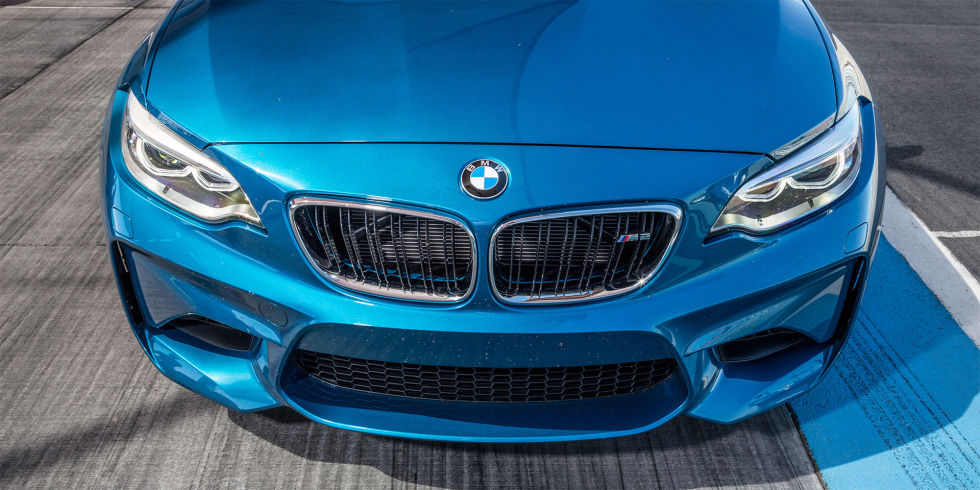
Evan Klein & Matt Tierney
Advertisement - Continue Reading Below

THE CAR WAITING AT THE CURB outside LAX Terminal 5 is a brand-new X5 M. Just in case I needed it, this SUV, here to carry our suitcases and photo gear, is a perfect reminder of what BMW does so well nowadays. Massive power enlisted in the cause of overcoming substantial weight. Enough computing power to sequence the human genome. A thoughtfully chosen palette of interior textures. Automatic transmission as standard equipment. It is effortlessly faster than pretty much every BMW ever sold in showrooms prior to the turn of the millennium, including the mighty M1 supercar.
Even in Los Angeles, the big red SUV is aspirational, causing heads in traffic to swivel as if they were ball-bearing-mounted, and I'm reluctantly impressed at how well it handles the cut-and-thrust battle with the taxis and Uber drivers on the way out of the airport terminal. The minute we turn the corner to our meeting point and I glimpse the metallic-blue M2 squatting on its black 19-inch wheels, however, I forget all about sport-utility vehicles, no matter what their Burgerkingring times might be.
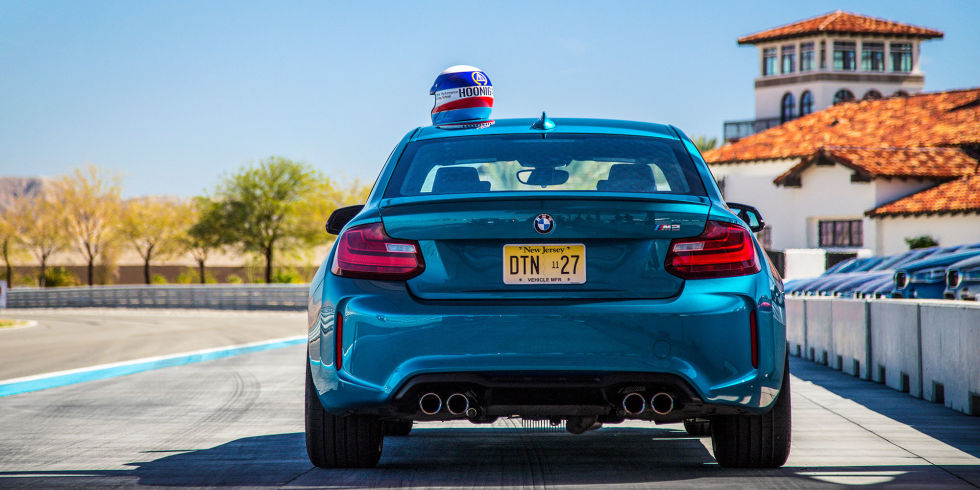
Evan Klein & Matt Tierney
The M2 is a proper BMW. Looks that way, in any event. The shape of the thing is absolutely and utterly correct. The 2-series is tall, narrow, and oddly proportioned—just like a 2002. Yet it looks appropriately vicious with its sculpted fender flares, kicked-up lip spoiler (which could have been made by Kamei 30 years ago), and a gaping air dam that brings to mind the menace of the E46 M3.
Web editor Travis Okulski and editor-at-large Sam Smith are milling around in the general direction of the M2's door handle, leaving me no time to spare. I beat them to it in unsubtle and graceless fashion, shoving past to fall into the deep bucket seat, poke the start button, and pair my phone before anybody can object. Unlike the 228i and M235i, the M2 is comprehensively equipped at its base price of $52,695. Our tester has two options. The paint, Long Beach Blue Metallic, is $550. And there's an Executive package consisting entirely of stuff you don't need; that's $1250 you can save. This M2 has a manual transmission, as do the white M235i and black 228i with M Sport package next to it. That's a lot of "M" badges, isn't it? And not a hand-assembled, high-revving "big six" to be found in the bunch.
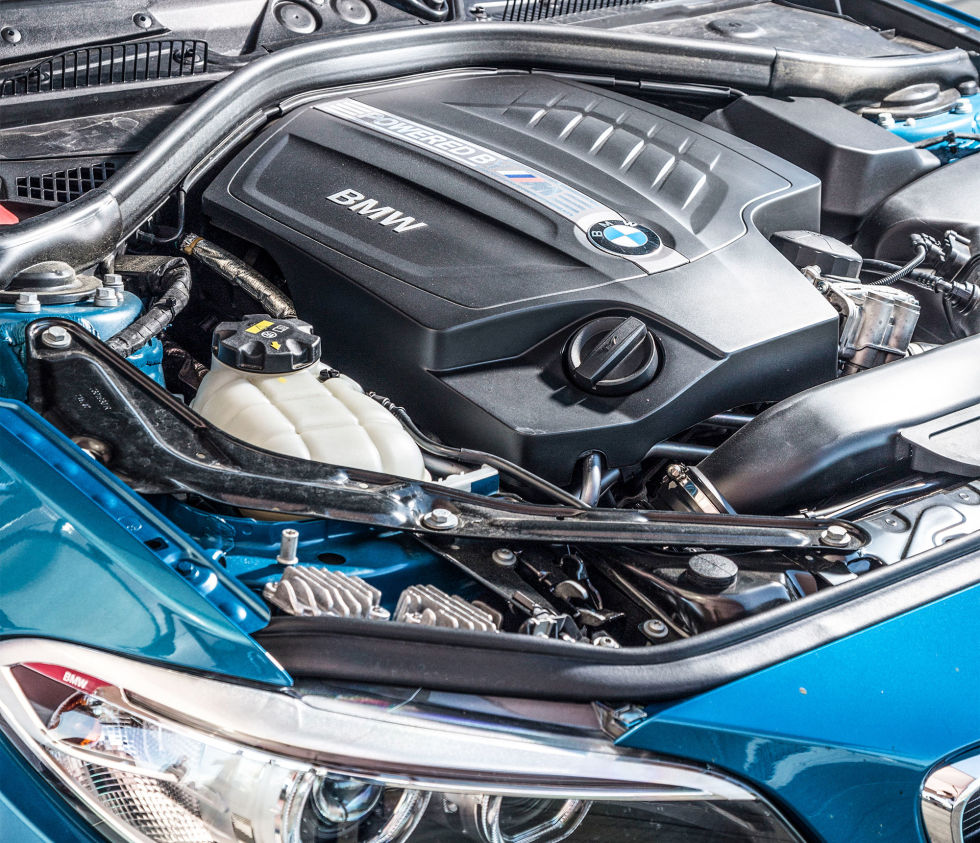
The 1M and the M2 have the same size high-performance tires—245/35ZR-19 at the front and 265/35ZR-19 at the rear—but the older car gives the distinct impression that these tires were fitted after the fact by a 16-year-old who also hammered out the fenders to fit. It displays all the classic tuner-car behaviors, from a disturbing variance in steering feel at different wheel angles to significant sensitivity under trail braking.
This is embarrassing. The script called for the computerized, market-researched M2 to be blown into the weeds by the soulful, old-school 1M. So far, though, it's not happening. Smith is scathing on the subject: "Everything about the 1M annoys me, from the limited production run to the way the fenders flare out. It's all so … calculated. The M2 just does everything so much better. It's all of one piece."
Next up: the M235i. This car's been bringing up the rear over the last 60 miles of challenging road, regardless of driver, and from the first fast corner, it's obvious why. There's no connection whatsoever to what the front wheels are doing. The steering has been tuned to deliver a reassuring amount of weight, but that weight smothers road feedback. With the M2, you're always aware of the moment in a corner where the outside front tire starts to roll onto the shoulder, and with the 1M, you're sort of browbeaten by that and other extraneous information. But with the M235i, you'd better drop the windows and listen for the change in what I like to think of as "the song of the tread."
The next time we come to a halt, I try to convince Okulski to trade me his 228i for my M235i. "It has satellite radio," I say. When that doesn't work, I run past him to the 228i and close the door, betting that Okulski has left the keys in it. Success.

At a whisker over 40 grand, this is a very well-equipped 228i, but it's still well over $10,000 cheaper than the other 2-series cars, and if you could do without some of the gingerbread, you could have it for $36,000. To put this in market perspective, the base price of the 2016 Toyota Camry XLE with a V-6 is $32,205.

PRIOR TO ARRIVING AT THE TRACK this morning, I'd thought that we would be running on the original Thermal Club circuit, now christened "South Palm" but familiar to me from our "Misfits" test in July 2014. Serves me right for not paying attention to instructions at dinner last night. We are actually booked for the new North Palm circuit. It's shorter, with average lap times of under one minute, and there's much less runoff space between the track and the intimidating Armco barriers on all sides. BMW uses it as a training facility and for a variety of customer experiences.
We start the day with a friendly dice between Okulski and me, swapping between the M2 and the 1M and running a few drag races on the main straight before getting into it for real. "The M2 definitely feels faster," Okulski notes. "More power in a straight line, and better gearing for this track."
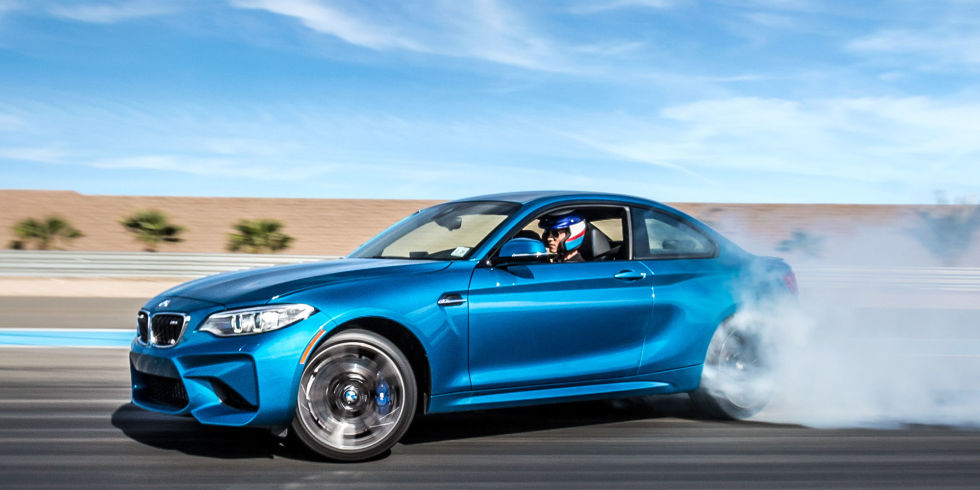
Evan Klein & Matt Tierney
In the fast carousel that serves as North Palm's signature feature, the M2 is notably faster and better-balanced than its predecessor, even when Okulski leaves the stability control in the more permissive M Dynamic mode. "The M2's gearbox is so much better than the 1M's," he says, a sentiment echoed by everybody but me. I'm finding it a pain to come up with second gear in the second-to-last turn, because the reverse detent spring is insufficiently serious about its job.
Features editor David Zenlea has no qualms about taking a few whacks at the 1M's sacred-cow status: "It looks cartoonish, it leans heavily in turns … and except for journalists and a few lucky owners, the 1M is basically unobtainium. I like that they're going to build a bunch of the M2."
Okulski and I hop into the M235i and 228i for a back-to-back run. In a straight line, there's no comparison; there's an 80-horse difference between the two, and when you're flat out past the flag, the six leaves the four for dead. But the faster car comes in for the lion's share of criticism in the postsession debriefing. "It's a Buick!" Smith says, and since he doesn't have fond memories of riding to school in a 1981 Century Estate Wagon like I do, I assume that's not a compliment.
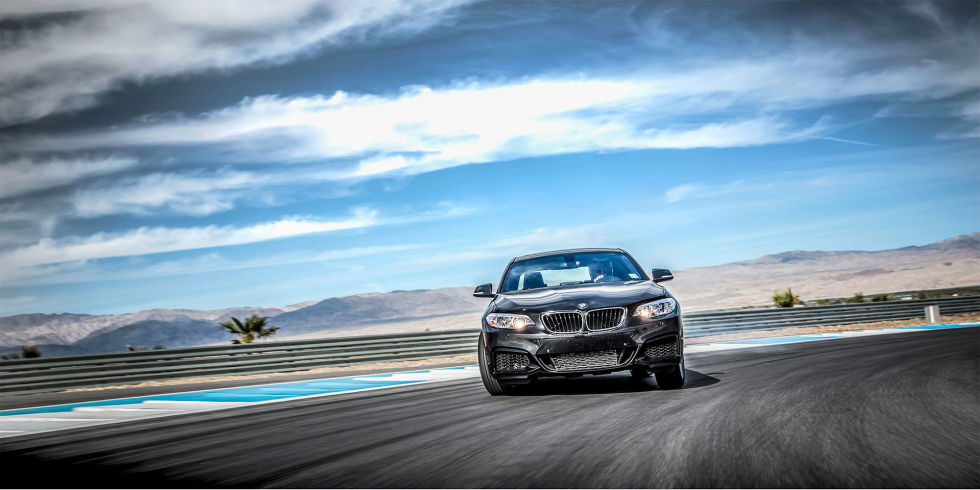 The hilarious part is that the 228i isn't that much slower than the other cars. In both my hands and the hands of Adam Seaman, senior lead instructor of BMW's Performance Center on-site, there's about a two-second gap between the 228i and the M235i. The M2 is just under a second quicker still. Yet there's less than three seconds overall between my best lap in the 228i and Seaman's best lap in the M2. "At a longer track, like Laguna Seca, with long straights, that gap would swell," Smith notes, and I can't disagree. But I'm willing to go a little slower to enjoy myself a little more, and so are Okulski and Zenlea.
The hilarious part is that the 228i isn't that much slower than the other cars. In both my hands and the hands of Adam Seaman, senior lead instructor of BMW's Performance Center on-site, there's about a two-second gap between the 228i and the M235i. The M2 is just under a second quicker still. Yet there's less than three seconds overall between my best lap in the 228i and Seaman's best lap in the M2. "At a longer track, like Laguna Seca, with long straights, that gap would swell," Smith notes, and I can't disagree. But I'm willing to go a little slower to enjoy myself a little more, and so are Okulski and Zenlea.
It's been quite a four-course meal, but I still have room for dessert. Time for the 1988 M3. As always, I'm charmed by this very compact sedan's upright windows and no-nonsense cockpit. The power is modest, even in comparison with the 228i, and the grip is similarly limited. Yet it inspires complete confidence from the first corner. The steering isn't particularly lively but is accurate and relatively low-geared, so you can twirl it with abandon.
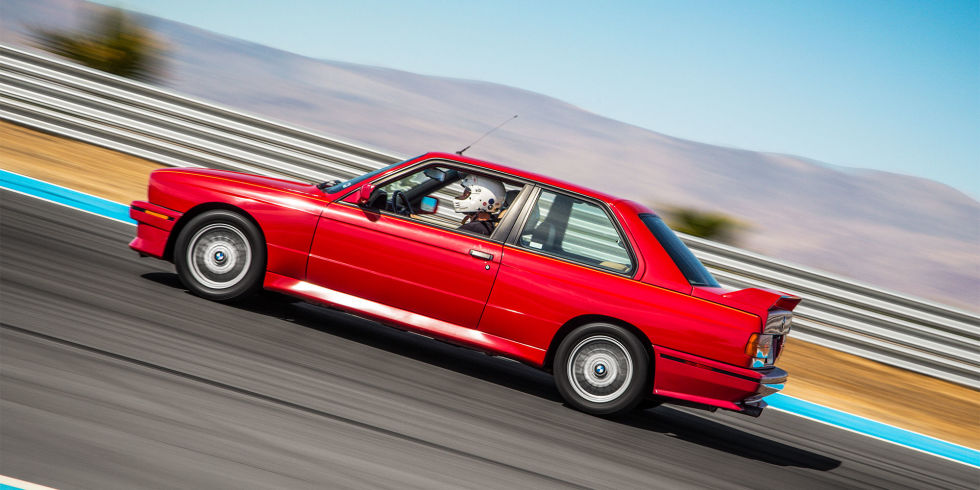
And twirl you will. Maybe it's the lower speeds, maybe it's the manageable size, maybe it's the low weight, but this is a car that you can drive right up to the limit of the tires and stay there. Hell, you can live there, for a dozen laps at a time. This is a car that creates hero drivers on the fly. Its default cornering stance under power is a sort of light drift, the body heeled wildly over and visibly twisting on the suspension in the manner of a Fox-body Mustang.
This is great fun and a forthright reminder of what makes a great BMW. You need a reasonable amount of power, you need slightly more grip than in the typical family sedan, and you need to be able to make big steering motions without winding up in the ditch. Note that I didn't say anything about the car being fast or setting brilliant lap times. The E30 M3 is about the tactile quality of the driving experience, not raw numbers.
Smith, our resident former Bimmer mechanic and E30 evangelist, insists that we all take extended stints in the M3 while he sits in the passenger seat and harangues us about the little coupe's excellence. Not that I need the sales pitch. The unfortunate truth is that none of the current cars rewards skill and punishes ineptitude quite as sharply as the original-gangster Deutsche Tourenwagen. It reminds me of my favorite university professors in that it punishes and praises both fairly and with heartfelt vigor.
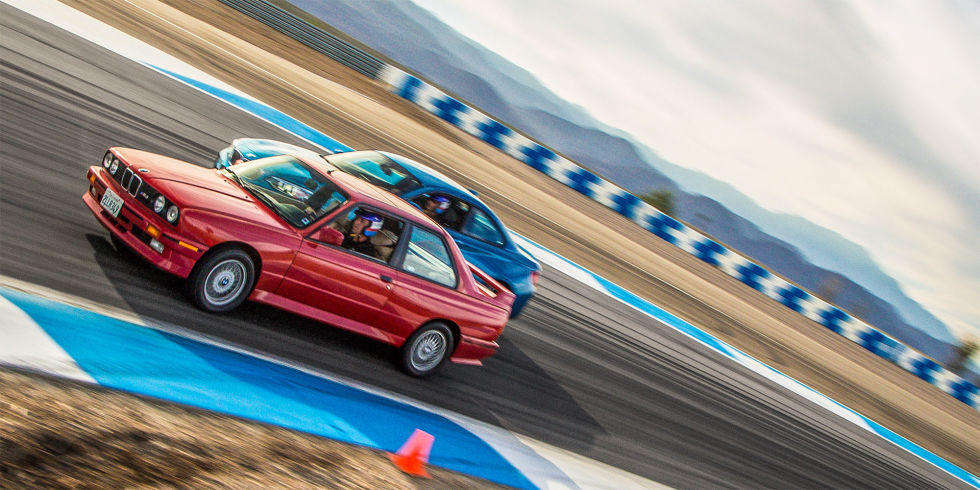
At the end of the day, we take a straw poll about the modern-era cars. The fourth-place car is clearly the M235i. It's fast, to be sure, and it's comfortable, but in this company, it's not focused enough. Third place, too, is easy: Give it to the 1M. "I just don't like the platform it's based on," Smith notes. Yeah, it has character, but so does the M2, and the M2 is simply a better-executed package that goes faster than the 1M while giving the driver less hassle about it.
At the top of the order, things get sticky. Okulski, Zenlea, and I are firmly in favor of the 228i, citing its superior steering feel, superb balance, and joyful demeanor at the limit of the tires. In fact, I argue that of our four modern Bimmers, only the 228i channels the old M3's balance and approachability. Smith concedes the point, but it's not enough for him. "Come on," he says, waving his hands in genuine agitation, "you can't tell me that you don't want the M2's motor and differential working for you when you go to track days." The argument continues over dinner, with neither side yielding an inch of ground. There's only one way to settle this.
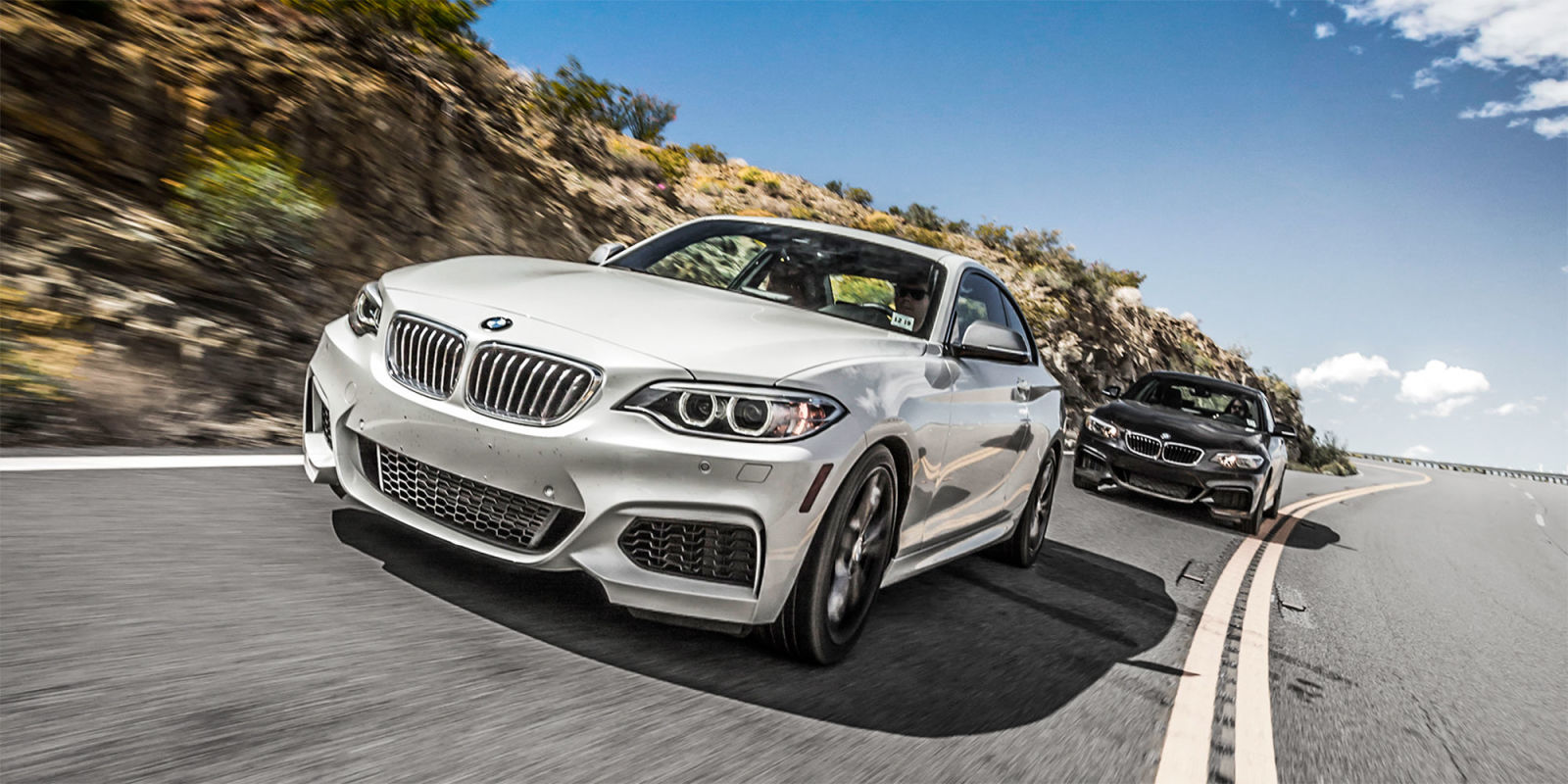

SHORTLY AFTER SUNRISE, all four coupes are lined up in a sand-covered turnoff area on Route 74 about halfway between the valley floor below and the Coachella Valley Vista Point above. This is where we'll decide, one way or another. I take the M2 keys, Smith grabs the 228i's, and we're off.
Once again, I can't help but love the M2's seven-league-boots' worth of motor and the way the nose refuses to dig into the ground under heavy braking.
But when we swap cars, I fall in love with the 228i all over again. There's so much more involvement on tap, from the extra shifts you need to keep the two-liter on its torque peak to the fingertip delicacy of turn-in at the fastest corners. On the street, you can't really take advantage of the M2's extra power, unless you have an attorney who can protect you from both traffic laws and Murphy's Law. Smith's right: At Laguna Seca, you want the M2, not this. But since when was driving a BMW ever about absolute lap times? That's why people buy Corvettes.
BMW drivers have traditionally looked for balance. They want something that can approximate the highway character of a Mercedes and the track-day focus of a Porsche in a single, tightly wrapped package. If it's affordable and cool-looking, so much the better.
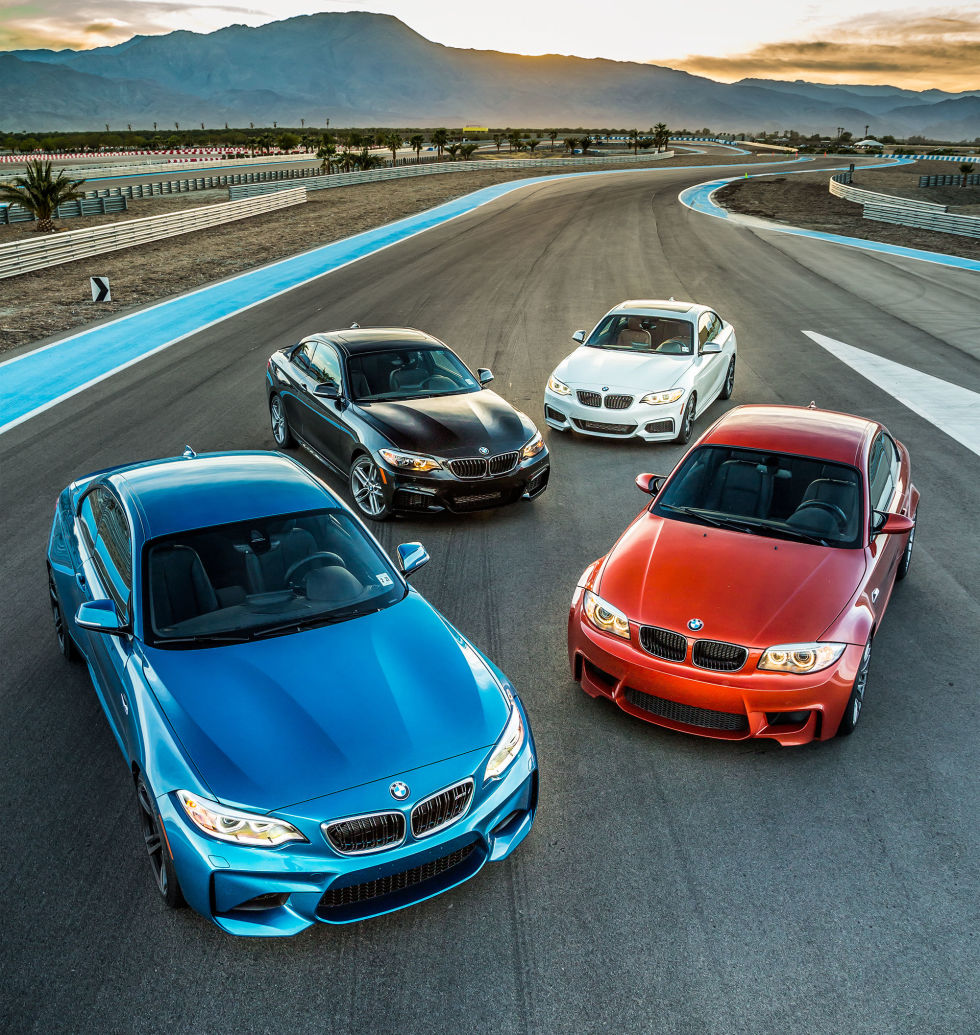
Evan Klein & Matt Tierney
With only a few minutes left before lunch, Smith turns to me. "Let's go in that again," he says, pointing to the 228i. I hop in on the shotgun side and watch the man at work. He's doing the same thing I was doing: making those extra shifts, leaning on the tires a bit more, sawing the wheel on corner exit for the sheer joy of doing so. At the vantage point, with the valley beneath us and waves of heat rising from the Bimmer's hood, he makes a half-hearted motion to me. "You don't want to drive down, do you?"
"Why don't you finish the drive," I reply, just as he'd hoped. With a brief spin of the tires on the shoulder, we're on the way back down. Smith's face is impassive behind his Ray-Bans, but we've raced together a few times, and from watching his hands, I can tell what he's thinking, because I'm thinking it as well: The 228i is our unanimous favorite. It's not really a modern E30 M3, but it captures that car's accessibility and agile spirit. Yes, the new M2 is brilliant, and the M235i is competent, but the 228i is special on both road and track. And though Smith's capitulation to this truth won't come without caveats, I know that he sees things my way. I knew he would even before we started that final drive up the mountain. After all, you can't lie to the mountain—and it can't lie to you.
Test Results

Tim Barker + Road & Track Staff
Throwback Stats and Track Times
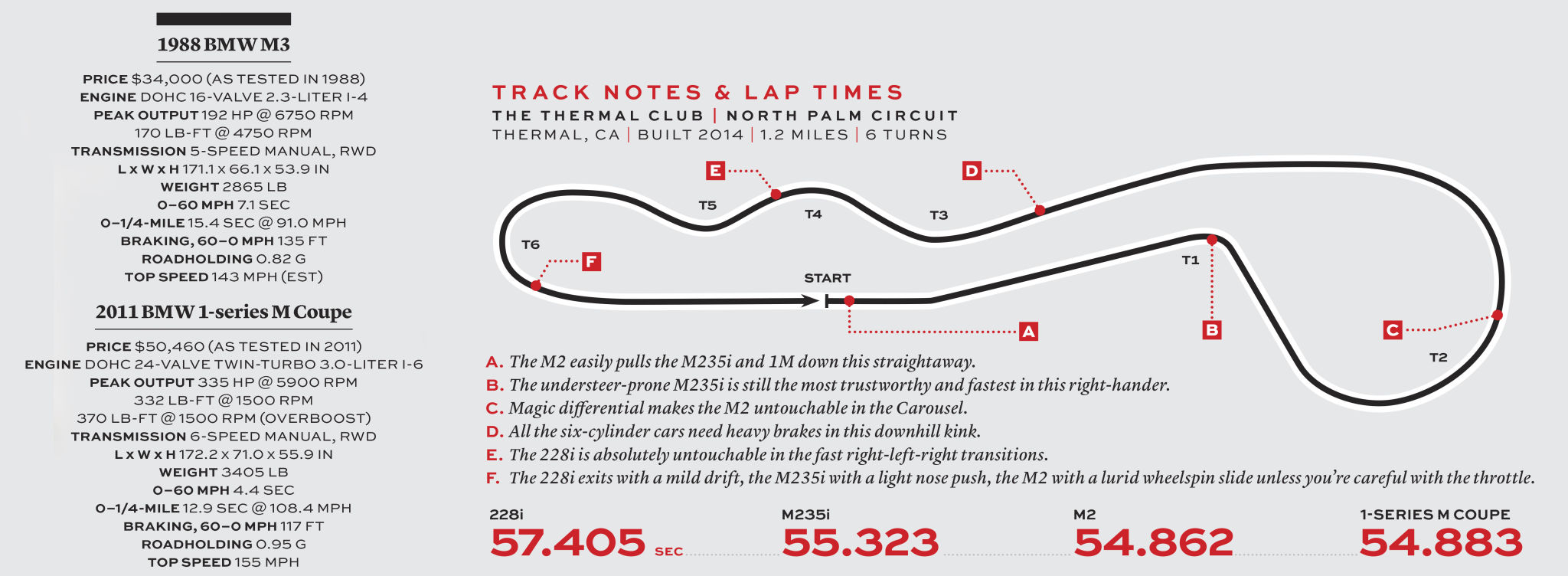
http://www.roadandtrack.com/car-culture/a29245/bmw-2-series-comparison-test/
228i, M235i, or M2: What's the Best BMW Coupe You Can Buy Today?
And just for good measure, we brought along a 1M and an E30 M3.
YOU CAN'T LIE TO THE MOUNTAIN. You can lie to your friends with facts and figures, spoilers and splitters. You can lie to the racetrack with absurd power, yards of tire width, and a double-clutch transmission. But you can't lie to the mountain, and on this Friday morning, the mountain is where we are headed.
California Route 74 sprints from Palm Desert to the ridgeline of the Santa Rosa Mountains, all decreasing-radius turns and roller-coaster straights up past the Coachella Valley Vista Point to the peaks beyond. Most of the turns are blind, the Scylla of black-spotted rock to the inside and thousand-foot drops inches off the gravel shoulder standing in for Charybdis. Then, appearing between the two, and flicking stones off the edge of the road to the valley below, our BMW convoy. Coupes, all of them, rude and stunted in their appearance, long hoods and short trunks, black kidney grilles between quad-round headlamps. Whistling and popping with the swell of pinwheel pressure in the manifold, revs rising and falling in that slightly imperfect way that signifies there are human hands and feet at work instead of the clinical perfection of the modern self-shifter.
Nearly fifty years ago, the original BMW 2002 ascended to Olympian status on this mountain and many others like it, converting an entire generation of British-ragtop enthusiasts with its previously unseen combination of Bavarian solidity and hooligan character. After the mild stumble of the underpowered 1977 320i, BMW struck gold with the next generation, dubbed E30. Although the six-cylinder 325i stole a million hearts and inspired the hugely popular Spec E30 race class, it was the four-cylinder M3 that served as justification for BMW's self-appointed tagline of "the Ultimate Driving Machine."

Evan Klein & Matt Tierney
Advertisement - Continue Reading Below

THE CAR WAITING AT THE CURB outside LAX Terminal 5 is a brand-new X5 M. Just in case I needed it, this SUV, here to carry our suitcases and photo gear, is a perfect reminder of what BMW does so well nowadays. Massive power enlisted in the cause of overcoming substantial weight. Enough computing power to sequence the human genome. A thoughtfully chosen palette of interior textures. Automatic transmission as standard equipment. It is effortlessly faster than pretty much every BMW ever sold in showrooms prior to the turn of the millennium, including the mighty M1 supercar.
Even in Los Angeles, the big red SUV is aspirational, causing heads in traffic to swivel as if they were ball-bearing-mounted, and I'm reluctantly impressed at how well it handles the cut-and-thrust battle with the taxis and Uber drivers on the way out of the airport terminal. The minute we turn the corner to our meeting point and I glimpse the metallic-blue M2 squatting on its black 19-inch wheels, however, I forget all about sport-utility vehicles, no matter what their Burgerkingring times might be.

Evan Klein & Matt Tierney
The M2 is a proper BMW. Looks that way, in any event. The shape of the thing is absolutely and utterly correct. The 2-series is tall, narrow, and oddly proportioned—just like a 2002. Yet it looks appropriately vicious with its sculpted fender flares, kicked-up lip spoiler (which could have been made by Kamei 30 years ago), and a gaping air dam that brings to mind the menace of the E46 M3.
Web editor Travis Okulski and editor-at-large Sam Smith are milling around in the general direction of the M2's door handle, leaving me no time to spare. I beat them to it in unsubtle and graceless fashion, shoving past to fall into the deep bucket seat, poke the start button, and pair my phone before anybody can object. Unlike the 228i and M235i, the M2 is comprehensively equipped at its base price of $52,695. Our tester has two options. The paint, Long Beach Blue Metallic, is $550. And there's an Executive package consisting entirely of stuff you don't need; that's $1250 you can save. This M2 has a manual transmission, as do the white M235i and black 228i with M Sport package next to it. That's a lot of "M" badges, isn't it? And not a hand-assembled, high-revving "big six" to be found in the bunch.

The 1M and the M2 have the same size high-performance tires—245/35ZR-19 at the front and 265/35ZR-19 at the rear—but the older car gives the distinct impression that these tires were fitted after the fact by a 16-year-old who also hammered out the fenders to fit. It displays all the classic tuner-car behaviors, from a disturbing variance in steering feel at different wheel angles to significant sensitivity under trail braking.
This is embarrassing. The script called for the computerized, market-researched M2 to be blown into the weeds by the soulful, old-school 1M. So far, though, it's not happening. Smith is scathing on the subject: "Everything about the 1M annoys me, from the limited production run to the way the fenders flare out. It's all so … calculated. The M2 just does everything so much better. It's all of one piece."
Next up: the M235i. This car's been bringing up the rear over the last 60 miles of challenging road, regardless of driver, and from the first fast corner, it's obvious why. There's no connection whatsoever to what the front wheels are doing. The steering has been tuned to deliver a reassuring amount of weight, but that weight smothers road feedback. With the M2, you're always aware of the moment in a corner where the outside front tire starts to roll onto the shoulder, and with the 1M, you're sort of browbeaten by that and other extraneous information. But with the M235i, you'd better drop the windows and listen for the change in what I like to think of as "the song of the tread."
The next time we come to a halt, I try to convince Okulski to trade me his 228i for my M235i. "It has satellite radio," I say. When that doesn't work, I run past him to the 228i and close the door, betting that Okulski has left the keys in it. Success.

At a whisker over 40 grand, this is a very well-equipped 228i, but it's still well over $10,000 cheaper than the other 2-series cars, and if you could do without some of the gingerbread, you could have it for $36,000. To put this in market perspective, the base price of the 2016 Toyota Camry XLE with a V-6 is $32,205.

PRIOR TO ARRIVING AT THE TRACK this morning, I'd thought that we would be running on the original Thermal Club circuit, now christened "South Palm" but familiar to me from our "Misfits" test in July 2014. Serves me right for not paying attention to instructions at dinner last night. We are actually booked for the new North Palm circuit. It's shorter, with average lap times of under one minute, and there's much less runoff space between the track and the intimidating Armco barriers on all sides. BMW uses it as a training facility and for a variety of customer experiences.
We start the day with a friendly dice between Okulski and me, swapping between the M2 and the 1M and running a few drag races on the main straight before getting into it for real. "The M2 definitely feels faster," Okulski notes. "More power in a straight line, and better gearing for this track."

Evan Klein & Matt Tierney
In the fast carousel that serves as North Palm's signature feature, the M2 is notably faster and better-balanced than its predecessor, even when Okulski leaves the stability control in the more permissive M Dynamic mode. "The M2's gearbox is so much better than the 1M's," he says, a sentiment echoed by everybody but me. I'm finding it a pain to come up with second gear in the second-to-last turn, because the reverse detent spring is insufficiently serious about its job.
Features editor David Zenlea has no qualms about taking a few whacks at the 1M's sacred-cow status: "It looks cartoonish, it leans heavily in turns … and except for journalists and a few lucky owners, the 1M is basically unobtainium. I like that they're going to build a bunch of the M2."
Okulski and I hop into the M235i and 228i for a back-to-back run. In a straight line, there's no comparison; there's an 80-horse difference between the two, and when you're flat out past the flag, the six leaves the four for dead. But the faster car comes in for the lion's share of criticism in the postsession debriefing. "It's a Buick!" Smith says, and since he doesn't have fond memories of riding to school in a 1981 Century Estate Wagon like I do, I assume that's not a compliment.

It's been quite a four-course meal, but I still have room for dessert. Time for the 1988 M3. As always, I'm charmed by this very compact sedan's upright windows and no-nonsense cockpit. The power is modest, even in comparison with the 228i, and the grip is similarly limited. Yet it inspires complete confidence from the first corner. The steering isn't particularly lively but is accurate and relatively low-geared, so you can twirl it with abandon.

And twirl you will. Maybe it's the lower speeds, maybe it's the manageable size, maybe it's the low weight, but this is a car that you can drive right up to the limit of the tires and stay there. Hell, you can live there, for a dozen laps at a time. This is a car that creates hero drivers on the fly. Its default cornering stance under power is a sort of light drift, the body heeled wildly over and visibly twisting on the suspension in the manner of a Fox-body Mustang.
This is great fun and a forthright reminder of what makes a great BMW. You need a reasonable amount of power, you need slightly more grip than in the typical family sedan, and you need to be able to make big steering motions without winding up in the ditch. Note that I didn't say anything about the car being fast or setting brilliant lap times. The E30 M3 is about the tactile quality of the driving experience, not raw numbers.
Smith, our resident former Bimmer mechanic and E30 evangelist, insists that we all take extended stints in the M3 while he sits in the passenger seat and harangues us about the little coupe's excellence. Not that I need the sales pitch. The unfortunate truth is that none of the current cars rewards skill and punishes ineptitude quite as sharply as the original-gangster Deutsche Tourenwagen. It reminds me of my favorite university professors in that it punishes and praises both fairly and with heartfelt vigor.

At the end of the day, we take a straw poll about the modern-era cars. The fourth-place car is clearly the M235i. It's fast, to be sure, and it's comfortable, but in this company, it's not focused enough. Third place, too, is easy: Give it to the 1M. "I just don't like the platform it's based on," Smith notes. Yeah, it has character, but so does the M2, and the M2 is simply a better-executed package that goes faster than the 1M while giving the driver less hassle about it.
At the top of the order, things get sticky. Okulski, Zenlea, and I are firmly in favor of the 228i, citing its superior steering feel, superb balance, and joyful demeanor at the limit of the tires. In fact, I argue that of our four modern Bimmers, only the 228i channels the old M3's balance and approachability. Smith concedes the point, but it's not enough for him. "Come on," he says, waving his hands in genuine agitation, "you can't tell me that you don't want the M2's motor and differential working for you when you go to track days." The argument continues over dinner, with neither side yielding an inch of ground. There's only one way to settle this.


SHORTLY AFTER SUNRISE, all four coupes are lined up in a sand-covered turnoff area on Route 74 about halfway between the valley floor below and the Coachella Valley Vista Point above. This is where we'll decide, one way or another. I take the M2 keys, Smith grabs the 228i's, and we're off.
Once again, I can't help but love the M2's seven-league-boots' worth of motor and the way the nose refuses to dig into the ground under heavy braking.
But when we swap cars, I fall in love with the 228i all over again. There's so much more involvement on tap, from the extra shifts you need to keep the two-liter on its torque peak to the fingertip delicacy of turn-in at the fastest corners. On the street, you can't really take advantage of the M2's extra power, unless you have an attorney who can protect you from both traffic laws and Murphy's Law. Smith's right: At Laguna Seca, you want the M2, not this. But since when was driving a BMW ever about absolute lap times? That's why people buy Corvettes.
BMW drivers have traditionally looked for balance. They want something that can approximate the highway character of a Mercedes and the track-day focus of a Porsche in a single, tightly wrapped package. If it's affordable and cool-looking, so much the better.

Evan Klein & Matt Tierney
With only a few minutes left before lunch, Smith turns to me. "Let's go in that again," he says, pointing to the 228i. I hop in on the shotgun side and watch the man at work. He's doing the same thing I was doing: making those extra shifts, leaning on the tires a bit more, sawing the wheel on corner exit for the sheer joy of doing so. At the vantage point, with the valley beneath us and waves of heat rising from the Bimmer's hood, he makes a half-hearted motion to me. "You don't want to drive down, do you?"
"Why don't you finish the drive," I reply, just as he'd hoped. With a brief spin of the tires on the shoulder, we're on the way back down. Smith's face is impassive behind his Ray-Bans, but we've raced together a few times, and from watching his hands, I can tell what he's thinking, because I'm thinking it as well: The 228i is our unanimous favorite. It's not really a modern E30 M3, but it captures that car's accessibility and agile spirit. Yes, the new M2 is brilliant, and the M235i is competent, but the 228i is special on both road and track. And though Smith's capitulation to this truth won't come without caveats, I know that he sees things my way. I knew he would even before we started that final drive up the mountain. After all, you can't lie to the mountain—and it can't lie to you.
Test Results

Tim Barker + Road & Track Staff
Throwback Stats and Track Times





 , aparte de su predilección por tunear los VWotijos, ya daban asquete hace 30 años.
, aparte de su predilección por tunear los VWotijos, ya daban asquete hace 30 años.


